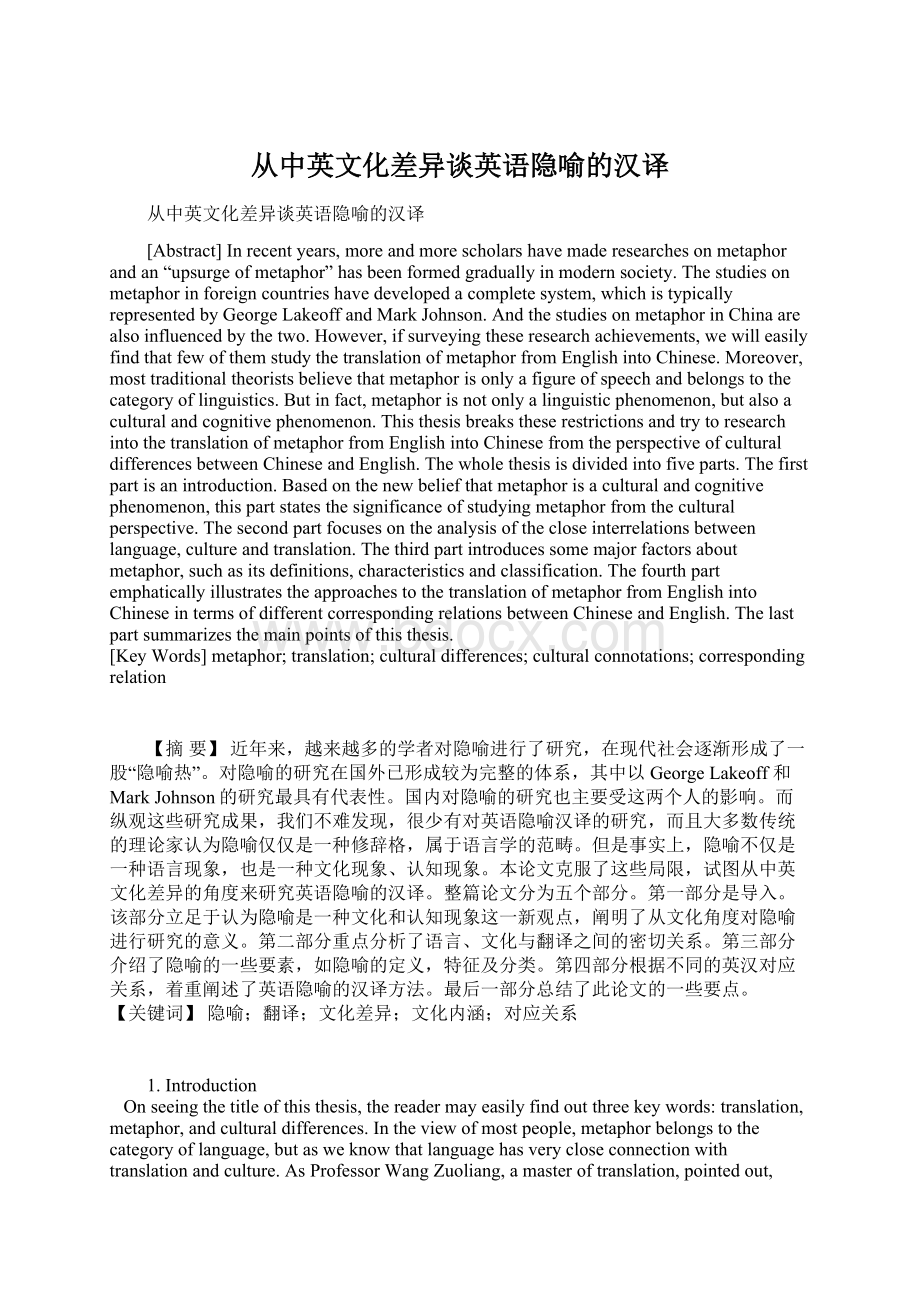从中英文化差异谈英语隐喻的汉译Word下载.docx
《从中英文化差异谈英语隐喻的汉译Word下载.docx》由会员分享,可在线阅读,更多相关《从中英文化差异谈英语隐喻的汉译Word下载.docx(13页珍藏版)》请在冰豆网上搜索。

culturalconnotations;
correspondingrelation
【摘要】近年来,越来越多的学者对隐喻进行了研究,在现代社会逐渐形成了一股“隐喻热”。
对隐喻的研究在国外已形成较为完整的体系,其中以GeorgeLakeoff和MarkJohnson的研究最具有代表性。
国内对隐喻的研究也主要受这两个人的影响。
而纵观这些研究成果,我们不难发现,很少有对英语隐喻汉译的研究,而且大多数传统的理论家认为隐喻仅仅是一种修辞格,属于语言学的范畴。
但是事实上,隐喻不仅是一种语言现象,也是一种文化现象、认知现象。
本论文克服了这些局限,试图从中英文化差异的角度来研究英语隐喻的汉译。
整篇论文分为五个部分。
第一部分是导入。
该部分立足于认为隐喻是一种文化和认知现象这一新观点,阐明了从文化角度对隐喻进行研究的意义。
第二部分重点分析了语言、文化与翻译之间的密切关系。
第三部分介绍了隐喻的一些要素,如隐喻的定义,特征及分类。
第四部分根据不同的英汉对应关系,着重阐述了英语隐喻的汉译方法。
最后一部分总结了此论文的一些要点。
【关键词】隐喻;
翻译;
文化差异;
文化内涵;
对应关系
1.Introduction
Onseeingthetitleofthisthesis,thereadermayeasilyfindoutthreekeywords:
translation,metaphor,andculturaldifferences.Intheviewofmostpeople,metaphorbelongstothecategoryoflanguage,butasweknowthatlanguagehasverycloseconnectionwithtranslationandculture.AsProfessorWangZuoliang,amasteroftranslation,pointedout,translationinvolveslanguageaswellasculture.[1]Translationisnotmerelyataskofreplacingonelanguagewithanother,butalsoneedstohaveagoodcommandofthetwodifferentculturesrepresentedbythetwodifferentlanguages.Whenweconcentrateontranslationstudies,weshouldattachgreatimportancetobothlanguageandculture.
Overthepasttwodecades,translationstudieshaveassumedasoundmomentumofadvancement,andculture,asanindispensablefactorintranslation,becomesincreasinglyimportant.Throughthoroughanalysis,wecanfindthattherearetwotendenciesintoday’sdevelopmentoftranslationstudies:
firstly,translationstudieshavebeenmoreandmoreintegratedwithcommunicationtheories;
secondly,thefocusoftranslationhasbeenshiftedfromlinguistictransfertoculturaltransfer.Basedonthesetwotendencies,manyscholarsengagedintranslationstudiesagreewiththeideathattranslationisanactofinterculturalcommunication.
Sincetranslationinvolvestwolanguagesandtwocultures,andindifferentculturalbackgrounds,therearedifferentlanguages.BothChineseandEnglisharegreatpeopleswithlonghistoryandrichculturalresources,andnaturallycolorfullanguages.Metaphor,asacategoryoflanguage,isacommonlinguisticphenomenoninbothChineseandEnglish,butmetaphorsinthesetwodifferentculturalbackgroundshavegreatdifferences.
Metaphordoesn’texistonthebirthofhuman.Withtheadvancementofhumancivilization,thelinguisticcompetenceofourancestorshadbeengreatlystrengthened.Theygraduallyacquiredthecapabilitytoexpresstheirideasthroughassociation.Inthisway,metaphor——oneofthemostimportantmeansofexpressioninhumanlanguagecameintobeing.Asthefoundationofmankind’sconceptualsystem,metaphoristhecommonfeatureofhumanlanguage.Ifthereisnometaphorinourlanguage,itwillbeveryhardforustoclearlyandvividlyexpressourideas,letalongsmoothandsuccessfulcommunication.[2]Traditionaltheoristsviewedmetaphorsimplyasanimportantstylisticdeviceofthepoeticimaginationandrhetoricalflourish,moreoveramatterofwordsratherthanthoughtoraction,butinfact,“metaphorispervasiveineverydaylife,notjustinlanguagebutalsointhoughtandaction.”[3]Ourordinaryconceptualsystem,intermsofwhichweboththinkandact,isfundamentallymetaphoricalinnature.JustasI.A.Richardscontends,“alllanguageandthoughtaremetaphorical,andmetaphoristhe‘omnipresentprincipleoflanguage’.”[4]
Fromtheimportanceofmetaphor,wecanseethattranslationofmetaphorhasgreatsignificancetotheculturaltranslation.PeterNewmarkhasstatedinApproachestoTranslationthatmetaphorisatthecenterofallproblemsoftranslationtheory,semanticsandlinguistics.[5]EspeciallyinEnglish,thereareagreatnumberofmetaphors.Ithadbeensaidthatthree-quartersoftheEnglishlanguageconsistsofmetaphors.InordertomasterEnglishandsuccessfullycompletethetaskoftranslationfromEnglishintoChinese,successfultranslationofEnglishmetaphorisessential.Therefore,inthispaper,theauthorattemptstodiscusstheproblemoftranslationofmetaphorfromEnglishintoChinesefromtheculturalperspectiveindetail.
Asfarastranslationtheoryisconcerned,thispaperadoptsEugeneA.Nida’sfunctionaltheory,i.e.“FunctionalEquivalence”:
theresponseofthereceptorstothetranslatedmessage=theresponseoftheoriginalreceptorstothemessagewhenitwasgiveninitsoriginalsetting.[6]Fromthispoint,weknowthatfortrulysuccessfultranslation,biculturalismisasimportantasbilingualism,andevenmoreimportantattimes.
2.Cultureandtranslation
2.1Culture
“Whatisculture?
”isaverydifficultquestion,becausecultureissuchacomplexconceptionandanenormoussubjectthatitisextremelyhardforpeopletogiveanexactdefinitiontoit.OneoftheoldestandmostquoteddefinitionsofculturewasformulatedbytheEnglishanthropologistSirEdwardBurnettTylorinPrimitiveCultures(1871).“Hedefinedcultureas‘acomplexwholewhichincludesknowledge,belief,art,law,morals,customsandanyothercapabilitiesandhabitsacquiredbymanasamemberofsociety’.”[7]
Althoughcultureisverycomplicated,wecanroughlyclassifyitintothreecategoriesinscope:
(a)materialculturewhichreferstoalltheproductsofmanufacture;
(b)institutedculturewhichreferstosocialsystem,religioussystem,ritualsystem,educatedsystemandkinshipsystemetc;
(c)mentalculturewhichreferstopeople’smentalitiesandbehaviors,theirbeliefs,perceptions,conceptsofvalue,thoughtpatternsetc,
Intheviewofmostanthropologists,culturepossessesthefollowingfeatures:
(a)cultureissociallyacquiredinsteadofbiologicallytransmitted;
(b)cultureissharedamongthemembersofacommunityinsteadofbeinguniquetoanindividual;
(c)cultureissymbolic.Languageisthemosttypicalsymbolicsystemwithinculture;
(d)cultureisintegrated.Eachaspectofcultureistiedinwiththeotheraspects.[8]
Sincelanguagesymbolizesandreflectsculture,languagecommunicationisactuallyakindofculturalcommunicationandthecommunicationbetweendifferentlanguagesisindeedcommunicationbetweendifferentcultures.Fromthisperspective,thetranslationoflanguageisessentiallythetranslationofculture,andtranslationstudiesshouldbeconductedinthecontextofculture.Inthenextsection,theauthorisgoingtodiscusstheinterrelationsbetweenlanguage,cultureandtranslation.
2.2Language,cultureandtranslation
Nobodywillsuspectthecloseinterrelationsbetweenlanguageandculture.Alanguagemaybeasmallbutindispensablepartofaculture.Therelationbetweenlanguageandcultureismutuallycauseandeffect.Theypenetrateintoeachotherandcannotexistwithouteachother.Cultureembracesandinfluenceslanguage.Intheprocessofcommunication,themeaningoflanguageisusuallydeterminedbyitsculturalcontext.Ontheotherside,languageistheimportantconstituentofcultureanditisalsoanessentialtoolforthereservation,communicationandreflectionofculture.[9]Inasense,languagecarriesculture,mirrorsculture,spreadscultureandhelpsdevelopculture.Itisnoexaggerationtosaythatlanguageisthelifebloodofcultureandcultureisthetrackalongwhichlanguageformsanddevelops.
Justbecauseofthecloserelationbetweenlanguageandculture,wehavetopayattentiontotheculturalcontextwhenweresearchintolanguage.Accordingtolinguistics,theoriginofhumanlanguageisalwaysconnectedwiththeoriginofhumanandhumansociety.Therefore,ifweneedtounderstandcertainlanguageandthelawsofitsdevelopment,wemustcloselyrelateittothehistoryofsocialdevelopmentofthislanguageandtothepeopleusingitanditshistory.Theexistenceofculturecannotdepartwithitscertainculturalcontext.[10]
Asfortherelationbetweencultureandtranslation,theauthorhasmentionedabove.Translationis,inessence,anactofinterculturalcommunication,andthetranslat